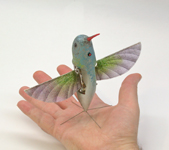First fully operational life-size hummingbird-like unmanned aircraft
February 21, 2011
AeroVironment, Inc. has announced controlled precision hovering and fast-forward flight of a two-wing, “hummingbird-like” flapping wing aircraft that carries its own energy source, and uses only flapping wings for propulsion and control.
(Videos)
Developed for the Defense Advanced Research Projects Agency (DARPA), the final concept demonstrator is called the “Nano Hummingbird” and is capable of climbing and descending vertically, flying sideways left and right, flying forward and backward, as well as rotating clockwise and counter-clockwise, under remote control and carrying a video camera payload. During the demonstration the Nano Hummingbird flew in and out of a building through a normal-size doorway.
The hand-made prototype aircraft has a wingspan of 16 centimeters (6.5 inches) tip-to-tip and has a total flying weight of 19 grams (2/3 ounce), which is less than the weight of a common AA battery. This includes all the systems required for flight; batteries, motors, communications systems and video camera. The aircraft can be fitted with a removable body fairing, which is shaped to have the appearance of a real hummingbird. The aircraft is larger and heavier than an average hummingbird, but is smaller and lighter than the largest hummingbird currently found in nature.
The technical goals for the Phase II effort were set out by DARPA as flight test milestones for the aircraft to achieve by the end of the contract effort. The Nano Hummingbird met all, and exceeded many, of the milestones:
1. Demonstrate precision hover flight within a virtual two-meter diameter sphere for one minute.
2. Demonstrate hover stability in a wind gust flight which required the aircraft to hover and tolerate a two-meter per second (five miles per hour) wind gust from the side, without drifting downwind more than one meter.
3. Demonstrate a continuous hover endurance of eight minutes with no external power source.
4. Fly and demonstrate controlled, transition flight from hover to 11 miles per hour fast forward flight and back to hover flight.
5. Demonstrate flying from outdoors to indoors, and back outdoors through a normal-size doorway.
6. Demonstrate flying indoors ‘heads-down’ where the pilot operates the aircraft only looking at the live video image stream from the aircraft, without looking at or hearing the aircraft directly.
7. Fly the aircraft in hover and fast forward flight with bird-shaped body and bird-shaped wings.
Adapted from materials provided by AeroVironment, Inc.
